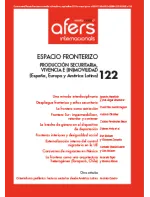A heterogeneous look at the border space: the case of the Tarapacá border (Chile)

Border areas have been and remain present in public discourse because of growing concern around the spaces they entail for the transfer of humans and goods. Taking this as a starting point, this paper discusses some analytical frameworks related to the notion of borders in order to locate the current discussion. On the one hand, it shows the tendency to associate borders with a limit marking the sovereignty of states and determining who is inside and who is outside. On the other, the focus on the national ignores the daily life unfolding in the border areas, whose constitution also demarcates conflict spaces. Using the Tarapacá border (Chile) as a case study, the analysis concludes that the functioning of the border acts as a heterogeneous architecture. It is also observed how it has changed in materiality and operates as a multilocal exclusion/inclusion mechanism.
Keywords: Chile,border, cross-border nationalism, control, border apparatus, Tarapacá
DOI: doi.org/10.24241/rcai.2019.122.2.187
>> The full text articles of this issue are available only in Spanish language
How to cite this article:
Ramos Rodríguez, Romina y Tapia Ladino, Marcela. «Una mirada heterogénea del espacio fronterizo: el caso de la frontera tarapaqueña (Chile)». Revista CIDOB d’Afers Internacionals, n.º 122 (septiembre de 2019), p. 187-210. DOI: doi.org/10.24241/rcai.2019.122.2.187